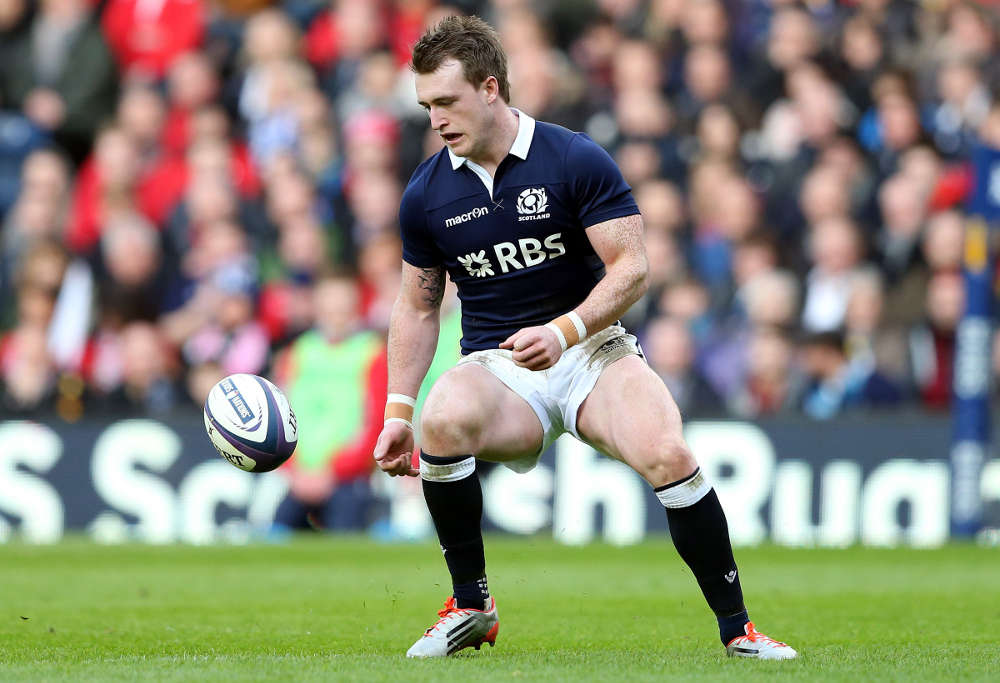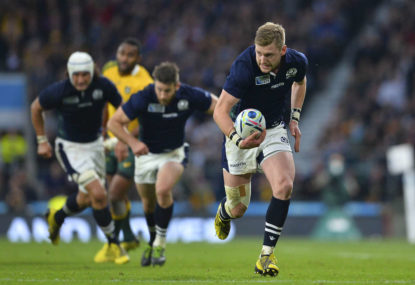In sport, as in all things, it’s the hope that kills you. It’s an adage that Scottish rugby fans, over the last few years, have come to appreciate.
In the early 2000s, Scottish rugby was in a slump. There were the occasional spikes and milestones along the way – take Calcutta Cup victories over the Auld Enemy at Murrayfield in 2006 and 2008, for example – but there was a real sense of unfulfilled ambition; a feeling that the great heroes of sides past were not being done justice for their work.
But on November 21, 2009, at a windy and wet Murrayfield, things started to subtly change.
On that day, Scotland produced a magnificent defensive display (with the help of a last-minute missed conversion from Matt Giteau) to snap a streak of 16 straight defeats to Australia with a 9-8 triumph.
The result sent shockwaves through international rugby – was the Scottish star on the rise again?
As it turned out, it was not to be. Poor showings in the Six Nations in 2010-12 seemed to put Scotland right back where they started, with people quick to write them off.
But then, again, they struck back against the criticism in the June of 2012, recording their first victory in Australia against the Wallabies since 1982, in Newcastle, making it consecutive victories against Australia to boot.
Again, they failed to capitalise on the promise, being beaten comfortably by New Zealand and South Africa in the autumn. Yet it was the loss to Tonga in that same series that had fans worried. This team was infrequently showing that they had the tools to compete with some of the world’s top teams and yet they were finding themselves sent back to square one with alarming regularity.
[latest_videos_strip category=”rugby” name=”Rugby”]
Their Six Nations form remained indifferent, if not poor, and yet on numerous occasions they were competitive against the might of the Southern Hemisphere in ways few fans would expect.
What fan will ever forget Scotland being robbed of a famous victory in the 2015 World Cup quarter-finals by Craig Joubert’s unfortunate misreading of an offside situation? They followed it up with another heartbreakingly close loss to the Wallabies in the autumn internationals of the following year.
That was the tale of Scottish rugby until 2017 – a rocky road with several moments that promised great things against more established opposition from elsewhere in the world, but failing to back it up and really create a sense of competitiveness when they came head-to-head with their Home Nations neighbours.
However, three wins in the 2017 Six Nations – their best return in a number of years – and a performance at Twickenham against England that belied their eventual 61-21 defeat, was a cause for optimism.
This was backed up by a barnstorming performance against the All Blacks that so nearly brought them a famous victory, and an absolute masterclass that put a reinvigorated Australia, who have themselves beaten New Zealand this year, to the sword in some style.
Since the autumn internationals of 2016, momentum has built, and has finally, seemingly, come to bear in the shape of a Scotland side that is confident, skillful, determined and ready to go toe-to-toe with anyone.
So, before looking ahead, we must ask: what is it about the 2017 Scotland team that made the difference?
Consistent selection
Back in the dark days, the Scottish side was chopped and changed so much, with new players ousted after one unremarkable performance, that it was impossible to develop combinations and allow a team spirit to manifest.
However, they now have a settled spine in the brilliance of Stuart Hogg at fullback, Finn Russell taking control of the 10 shirt, the leadership and accuracy of Greig Laidlaw at scrum half, the world-wisdom and work rate of John Barclay and the Gray brothers in the back-five forwards, and the development of a genuinely competitive scrum unit in the shape of WP Nel and Darryl Marfo, ably supported by the likes of Zander Fagerson.
While I have my reservations about Greig Laidlaw despite his obvious qualities – it was telling, for example, that Scotland produced their best attacking displays of a generation this autumn when he was injured – this consistency of selection does wonders for any team.

AP Photo/Scott Heppell
Stardust in the backs
There was a time when tries were so hard to come by in Scottish rugby. In 2008, for example, Scotland had not scored one at Murrayfield for over a year. Yet skip on nine years, and they put eight past Australia.
This clearly to a backline that is brimming not only with talent, but the mental strength and accuracy to convert their chances.
Hogg at fullback is one of the great stars of world rugby, and has already been discussed as Scotland’s greatest ever player (a tad premature, but you can see why). Tommy Seymour and Tim Visser are starting to prove themselves as genuine finishers, while the likes of Alex Dunbar and Huw Jones in the centres are showing their class too.
Add to that a more experienced and confident Russell in the 10 shirt (incidentally under the guidance of perhaps Scotland’s best ever 10, but I’ll come to that), and you suddenly have a backline that can look threatening on every attacking phase.
Strength in depth
Pinpointing which names to use in the previous section was a difficult task, and that leads me onto the fact that Scotland now has the kind of strength in depth they couldn’t have possibly imagined five years ago.
The fact that Scotland put so many points past Australia without the likes of Hogg, Laidlaw and Alex Dunbar highlights the fact that there are players outside their best team who can genuinely compete for places.
I look at Sean Maitland, Lee Jones and Byron McGuigan (who was excellent on debut against the Wallabies, incidentally) in the back three, Peter Horne and World Cup (almost) hero Mark Bennett in the centres, Ali Price and Henry Pyrgios competing for the 9 shirt (and that’s not even mentioning Sam Hidalgo-Clyne). And that’s just the backs.
John Hardie was absent in the autumn, but Hamish Watson has done his job with aplomb, and guys like Grant Gilchrist and Ben Toolis are giving the Gray brothers a run for their money.
Scotland is seriously stacked with talent, meaning that if they get injuries, it just gives someone else an opportunity – that is how the best sides work.
Gregor Townsend
TArguably biggie. Argubaly Scotland’s greatest No.10, Gregor Townsend took the Scotland job this summer with much fanfare, given his remarkable achievements at Glasgow Warriors over the last few years.
Already, he has stamped his mark on this side in a way that cannot be overlooked. He seems to have completely taken the leash off and imbued them with the confidence that they really can go toe-to-toe with the best.
Other Scottish coaches of years past, sadly, took too much of an attitude of defensive rugby against the best, which meant the attacking side of their game had no chance to develop. But Townsend has clearly not only encouraged them to attack but to take risks, to chance their arm, and it has worked wonders.
That kind of system gets the best out of your star players, like Hogg, and it also gives the team the confidence that their coach believes in them and thinks they can do it. It is hard to over-estimate how much of a lift that would have been to the squad.
As a side note, Townsend’s knowledge and wisdom about playing 10 at international level is being channelled into Finn Russell, and the results are showing. His game management is coming on leaps and bounds, they now play to Russell’s spontaneous and imaginative nature, and he has been given control of this team. Player, play on.
So there it is – the conclusions I have drawn that make me think that, this time, Scotland are the real deal.
But that comes with one caveat – they need to prove it in the 2018 Six Nations. Their record of getting up for games against the big sides and falling down against lesser nations is their Achilles heel – with all their success, they still lost to Fiji and got a scare from Samoa this year, so that says there is still work to be done.
If they can make a genuine play at the Six Nations title next year, it will confirm that Scotland are here to stay.
All the evidence and the change in their setup points to a foundation being built for a long-term successful side – now they just have to prove it to the world.






























































































